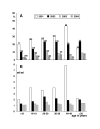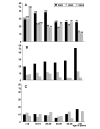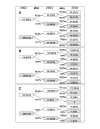Impact of two rounds of mass drug administration using diethylcarbamazine combined with albendazole on the prevalence of Brugia timori and of intestinal helminths on Alor Island, Indonesia
- PMID: 16014169
- PMCID: PMC1201159
- DOI: 10.1186/1475-2883-4-5
Impact of two rounds of mass drug administration using diethylcarbamazine combined with albendazole on the prevalence of Brugia timori and of intestinal helminths on Alor Island, Indonesia
Abstract
Background: Annual mass drug administration (MDA) using diethylcarbamizine (DEC, 6 mg/kg) combined with albendazole (alb, 400 mg) is recommended by the Global Programme to Eliminate Lymphatic Filariasis (GPELF). This strategy has been shown to be efficient in the of control bancroftian filariasis, but data on brugian filariasis as well as on the positive side effects on intestinal helminths are lacking.
Methods: The effect of one selective treatment and two rounds of MDA using DEC and alb on the prevalence and intensity of Brugia timori infection were studied on Alor island using a cross-sectional and a cohort approach. Before the campaign and ten months after each treatment cycle microfilariae (mf) were assessed by filtration of night blood. Before and ten months after MDA, stool samples were collected and the prevalence of intestinal helminths were determined.
Results: In all, the mf-rate dropped from 26.8% before any treatment to 3.8% following the second MDA. Almost all mf-positive, treated individuals showed very low mf densities. The crude prevalence of hookworm dropped from 25.3% to 5.9%. The reduction of prevalence of Ascaris lumbricoides (32.3% to 27.6%) and Trichuris trichiura (9.4% to 8.9%) was less pronounced. Within a cohort of 226 individuals, which was examined annually, the prevalence of A. lumbricoides dropped from 43.8% to 26.5% and of T. trichiura from 12.8% to 6.6%. The results indicate that this MDA approach reduces not only the mf prevalence of B. timori but also the prevalence of hookworm and to a lesser extent also of A. lumbricoides and T. trichiura.
Conclusion: The MDA using DEC and alb as recommended by GPELF is extremely effective for areas with brugian filariasis. The beneficial effect of MDA on intestinal helminths may strengthen the national programme to eliminate lymphatic filariasis in Indonesia and may set resources free which are otherwise used for deworming campaigns of schoolchildren.
Figures




References
-
- Horton J, Witt C, Ottesen EA, Lazdins JK, Addiss DG, Awadzi K, Beach MJ, Belizario VY, Dunyo SK, Espinel M, Gyapong JO, Hossain M, Ismail MM, Jayakody RL, Lammie PJ, Makunde W, Richard-Lenoble D, Selve B, Shenoy RK, Simonsen PE, Wamae CN, Weerasooriya MV. An analysis of the safety of the single dose, two drug regimens used in programmes to eliminate lymphatic filariasis. Parasitology. 2000:147–160. doi: 10.1017/S0031182000007423. - DOI - PubMed
LinkOut - more resources
Full Text Sources
Research Materials
Miscellaneous

